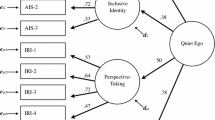Abstract
This study investigates the relationship between two primary motivational components of the self-concept: self-esteem and self-consistency. Past research has shown that high self-esteem is associated with greater consistency. Developed from theories of the self-concept, a structural model relating these two constructs was posited such that (1) self-esteem is causally prior to self-consistency, and (2) the effect of self-esteem is (at least partially) mediated by other components of the self-concept (self-consciousness, the tendency to fantasize, and the tendency to present a false front by hiding one's feelings). Utilizing a structural equation model with unobserved variables, an analysis of covariance structures was applied simultaneously but separately to data from a sample of boys and girls (ages 8–19). Results showed that the direct effect of self-esteem on self-consistency was stronger for boys than for girls. Further, the mediational properties of the other self-concept components also varied across gender. These differences are interpreted in light of theories of gender socialization.
Similar content being viewed by others
References
Block, J. H. (1973). Conceptions of sex role: Some cross-cultural and longitudinal perspectives.Am. Psychol. 28: 512–526.
Deaux, K. (1976).The Behavior of Women and Men. Brooks/Cole, Monterey, CA.
Elliott, G. C. (1982). Self-esteem and self-presentation among the young as a function of age and gender.J. Youth Adoles. 11: 135–155.
Elliott, G. C. (1984). Dimensions of the self-concept: A source of further distinctions in the nature of self-consciousness.J. Youth Adoles. 13: 285–309.
Elliott, G. C. (1986). Self-esteem and self-consistency: A theoretical and empirical link between two primary motivations.Social Psychol. Q. 49: 207–218.
Elliott, G. C., Rosenberg, M., and Wagner, M. (1984). Transient depersonalization in youth.Social Psychol. Q. 47: 115–129.
Hoffman, L. W. (1972). Early childhood experiences and women's achievement motives.J. Social Issues 28: 129–155.
Huston, A. C. (1982). Sex typing. In Mussen, P. H. (ed.),Carmichael's Manual of Child Psychology, Vol. 2 (3rd Ed.). Wiley, New York.
Johnson, M. M. (1975). Fathers, mothers, and sex typing.Sociol. Inquiry 45: 15–26.
Joreskog, K. G. (1979). Structural equation models in the social sciences: Specification, estimation, and testing. In Joreskog, K. G., and Sorbom, D. (eds.),Advances in Factor Analysis and Structural Equation Models. Abt Books, Cambridge, MA.
Joreskog, K. G., and Sorbom, D. (1984).Lisrel VI: Analysis of Linear Structural Relationships by the Method of Maximum Likelihood. Scientific Software, Mooresville, IN.
Lipman-Blumen, J. (1984).Gender Roles and Power. Prentice-Hall, Englewood Cliffs, NJ.
Maccoby, E. E., and Jacklin, C. N. (1974).The Psychology of Sex Differences. Stanford University Press, Stanford, CA.
Mead, G. H. (1934).Mind, Self and Society. University of Chicago Press, Chicago.
Pleck, J. H. (1975). Masculinity-femininity: Current and alternate paradigms.Sex Roles 1: 161–178.
Rebecca, M., Hefner, R., and Oleshansky, B. (1976). A model of sex-role transcendence.J. Social Issues 32: 197–206.
Rosenberg, F., and Simmons, R. G. (1975). Sex differences in the self-concept in adolescence.Sex Roles 1: 147–159.
Rosenberg, M. (1965).Society and the Adolescent Self-Image. Princeton University Press, Princeton, NJ.
Rosenberg, M. (1979).Conceiving the Self. Basic Books, New York.
Rosenberg, M., and Simmons, R. G. (1972).Black and White Self-Esteem: The Urban School Child. Rose Monograph Series. American Sociological Association, Washington, D.C.
Simmons, R. G., and Rosenberg, F. (1975). Sex, sex roles, and self-image.J. Youth Adoles. 4: 229–258.
Author information
Authors and Affiliations
Additional information
Received Ph.D. in Sociology from the University of Wisconsin, Madison. His major research interest include the self-concept of young children, fairness in social relationships, and impression management.
Rights and permissions
About this article
Cite this article
Elliott, G.C. Gender differences in self-consistency: Evidence from an investigation of self-concept structure. J Youth Adolescence 17, 41–57 (1988). https://doi.org/10.1007/BF01538723
Received:
Accepted:
Issue Date:
DOI: https://doi.org/10.1007/BF01538723




